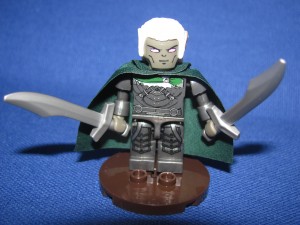Welcome to Purple Pawn, covering games played around the world by billions of people every day.
Second Look—Dungeons & Dragons Kre-O
14 Feb
Posted by David Miller as Miniatures, Other, RPGs, War Games
Using construction bricks and minifigures for roleplaying or war games isn’t anything new. Yet to have products designed specifically for Dungeons & Dragons is pretty exciting! Thus I wasted no time in picking up a few of the just released Dungeons & Dragons Kre-O sets from Hasbro. (See my photos below.)
In case you’re not familiar with it, Kre-O is Hasbro’s system of plastic construction bricks, compatible with Lego. There are Kre-O lines for Transformers, G.I. Joe, Star Trek, CityVille Invasion, and Battleship. Among those the company has added some nice lighting and motion enhancements to the basic interlocking pieces.
While for the D&D series I haven’t seen anything high-tech, I am so far impressed with both the quality and thematic style. The fit and sturdiness of the Kre-O pieces is comparable to Lego—perhaps not equal, but comparable. The bricks hold together well; they’re neither loose nor particularly difficult to separate. And the recommended builds certainly provide the expected somewhat-dark, fantasy medieval vibe, with details such as torches, banners, and battlements. A building in one of my sets has a golden sword hidden in the attic—I’m sure there’s a story behind that.
 One of the features that Hasbro is promoting in its Dungeons & Dragons Kre-O line is a modular construction approach that the company calls “Rapid Rebuild”. For example, the Battle Outpost set I purchased has a castle wall section, a castle corner section, and a tavern section. These can be kept separate, or with little knobs that fit in to holes on their sides, they can be locked together in various configurations.
One of the features that Hasbro is promoting in its Dungeons & Dragons Kre-O line is a modular construction approach that the company calls “Rapid Rebuild”. For example, the Battle Outpost set I purchased has a castle wall section, a castle corner section, and a tavern section. These can be kept separate, or with little knobs that fit in to holes on their sides, they can be locked together in various configurations.
Kre-O minifigures, which Hasbro calls “Kreons”, are nicely detailed. For example, rather than painted-on armor, the orc Kreon’s breastplate and the barbarian’s shoulder-plates are separate pieces. Drizzt, of course, has finely sculpted white hair. Kreon arms and legs, in fact, have more freedom of movement than Lego minifigs.
Siege weapons come with certain of the larger sets and are also sold separately. There are catapults, lightning canons, and ballistae (though Hasbro’s just calling them crossbows), which shoot marbles, arrows, and rings, respectively.
One of the things that excited me pre-release was the understanding that there would be a game component to Dungeons & Dragons Kre-O. And though they’re not much, there are in fact two recommended ways to play, with more possibly coming later. The first game option is to use the provided challenge cards, which specify targets for the various siege weapons and a limit to the number of attempted shots.
The second game, only slightly more involved, has players trying to knock over each other’s Kreons. But to do so, they must take turns, drawing from separate decks of character cards (every Kreon comes with a card) to see how many shots they get to take. The player with the last figure standing is the winner.
Interestingly, character cards also show four numeric stats, which based on the symbols I take to mean weapons, armor, speed, and magic. Drizzt, for example, has weapons of 51 and magic of 45. An orc swordsman has weapons of 37 and magic of 14. However, nothing in the package suggests any use for these numbers.
Price-wise, I think Kre-O is quite reasonable. I purchased the Battle Outpost, which includes three Kreons and 176 pieces, for $17. The 22 piece Drizzt set was only $4.
Overall then, my initial excitement for Dungeons & Dragons Kre-O remains. Not only am I having fun with it as an adult, I think it has great potential to inspire younger gamers.
No Comments
Sorry, the comment form is closed at this time.
Trending
- Massdrop.com
- Oh the Irony—Illuminati Card Game Continues to Inspire Conspiracy Theorists
- Home
- Footprints, an Educational Ecology Game
- USPS Adds Board Game Flat Rate Box
- Baila, the Estonian Drinking Card Game
- Crystal Caste Wins Dice Patent Suit Against Hasbro
- Mirror Game, Red and Blue
- Are Board Games Dangerous?
- The Truth About Dominoes On Sunday in Alabama
Archives
Most Popular Articles
- Oh the Irony—Illuminati Card Game Continues to Inspire Conspiracy Theorists
- The 20 Most Valuable Vintage Board Games
- The Truth About Dominoes On Sunday in Alabama
- Sequence Game, and Variants
- USPS Adds Board Game Flat Rate Box
- Baila, the Estonian Drinking Card Game
- The 13 Most Popular Dice Games
- Are Board Games Dangerous?
- Guess Who? The Naked Version
- What Happened to the Jewel Royale Chess Set?
Recent Posts
- Toy Fair 2019—Breaking Games
- Talisman Kingdom Hearts Edition
- Toy Fair 2019—Winning Moves
- Toy Fair 2019—Games Workshop
- Toy Fair 2019—Star Wars Lightsaber Academy
- Toy Fair 2019—Stranger Things Games
- Toy Fair 2019—HABA
- Licensing Roundup
- Game Bandit
- 2018 A Difficult Year For Hasbro But Not For D&D Or MtG
Recent Comments
- on Toy Fair 2019—Winning Moves
- on Game Bandit
- on Second Look—Dungeons & Dragons Waterdeep Dragon Heist
- on Crowdfunding Highlights
- on Beyblade SlingShock
- on Game Bandit
- on Game Bandit
- on Watch This Game!, the Board Game Review Board Game
- on Second Look—Vampire: The Masquerade 5th Edition
- on Palladium Books Loses Robotech IP License, Cancels Five-Year-Overdue Robotech RPG Tactics Kickstarter




